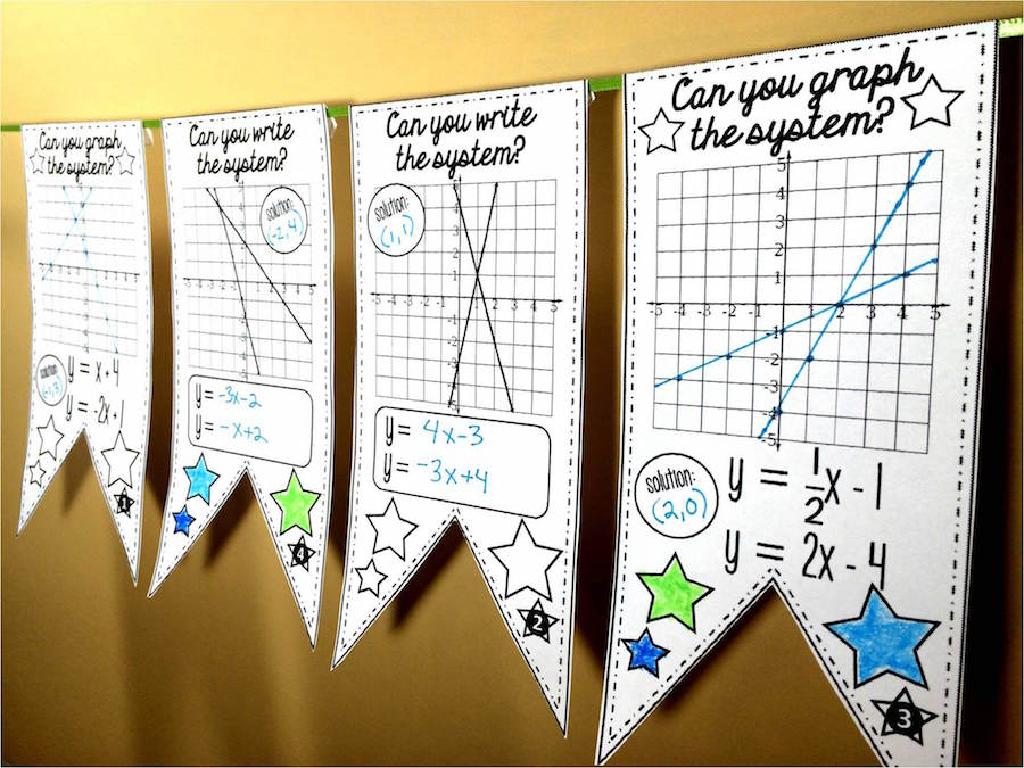Interior Angles Of Polygons
Subject: Math
Grade: Eighth grade
Topic: Two-Dimensional Figures
Please LOG IN to download the presentation. Access is available to registered users only.
View More Content
Interior Angles of Polygons
– Basics of 2D shapes
– Shapes on a flat surface with length and width
– Importance of angles in geometry
– Angles help determine shape properties and structure
– Calculating interior angles
– Sum of interior angles: (n-2) x 180°, where n is the number of sides
– Practical applications of angle knowledge
– Used in construction, art, and design to create precise figures
|
This slide introduces the concept of two-dimensional shapes and focuses on the interior angles of polygons, which are crucial in understanding geometric principles. Emphasize the importance of angles in defining the structure and properties of shapes. Teach students the formula for calculating the sum of interior angles of a polygon, which is (n-2) times 180 degrees, where ‘n’ is the number of sides. Discuss how this knowledge is applied in real-world scenarios such as construction, art, and design, highlighting the practicality of geometry in everyday life. Encourage students to think of examples where they encounter different polygons and their angles.
Exploring Polygons
– Define a polygon
– A flat shape with straight sides that are fully closed
– Characteristics of polygons
– Polygons have vertices, edges, and interior angles
– Real-life polygon examples
– Think of stop signs, frames, or tiles
– Classifying polygons
– Based on the number of sides: triangles, quadrilaterals, pentagons, etc.
|
Begin the lesson by defining a polygon as a two-dimensional figure with straight sides that form a closed shape. Discuss the characteristics such as vertices (corners), edges (sides), and interior angles, which are the angles inside the polygon. Provide real-life examples to help students identify polygons in the world around them, such as stop signs (octagons), picture frames (rectangles), or floor tiles (various polygon shapes). Encourage students to classify polygons based on the number of sides they have, which will lead into a deeper discussion about the properties of different types of polygons, such as triangles, quadrilaterals, pentagons, and so on. This slide sets the foundation for understanding more complex concepts related to polygons.
Exploring Types of Polygons
– Classify by sides: triangles, quadrilaterals, etc.
– Triangles have 3, quadrilaterals have 4, and so on.
– Regular vs. Irregular polygons
– Regular polygons have equal sides and angles; irregular do not.
– Convex vs. Concave polygons
– Convex polygons have outward facing angles; concave have inward.
– Understanding polygon properties
|
This slide introduces students to the classification of polygons. Start by explaining that polygons can be categorized by the number of sides they have, such as triangles with three sides, quadrilaterals with four, and so on. Then, distinguish between regular polygons, which have all sides and angles equal, and irregular polygons, which do not. Next, discuss the difference between convex polygons, where all interior angles are less than 180 degrees and no sides cave in, and concave polygons, where one or more interior angles are greater than 180 degrees, resulting in a caved-in side. Use this slide to build a foundation for understanding the properties of polygons, which will be crucial for later discussions on interior angles and their calculations.
Understanding Angles in Polygons
– Define an angle
– An angle is formed by two rays with a common endpoint, called the vertex.
– Explore angle types
– Acute: 90°, Straight: 180°
– Measure angles with a protractor
– Use a protractor to measure the angle’s size in degrees.
– Angle types in polygons
– Polygons have various angles; knowing types helps in identification.
|
Begin with the definition of an angle to ensure students understand the basic concept. Discuss the different types of angles, providing visual examples for each: acute, right, obtuse, and straight. Demonstrate how to use a protractor to measure angles, possibly with a hands-on activity. Emphasize the relevance of understanding angle types when studying polygons, as this knowledge is crucial for identifying and calculating the properties of two-dimensional figures. Encourage students to bring a protractor to the next class for a practical exercise on measuring angles within polygons.
Interior Angles of Polygons
– Define interior angles
– Angles inside a polygon that are formed by two adjacent sides
– Identifying angles in polygons
– Look at corners where sides meet inside shapes like triangles, squares
– Sum of interior angles formula
– (Number of sides – 2) x 180° gives the sum of interior angles
– Practice with different polygons
– Use the formula to calculate angles in triangles, quadrilaterals, etc.
|
Begin with a clear definition of what interior angles are, emphasizing that they are located within the boundaries of a polygon. Show visual examples of interior angles in various polygons, such as triangles and rectangles, to help students identify them. Explain the formula for finding the sum of interior angles, which is based on the number of sides the polygon has. Provide practice problems for students to apply the formula to different polygons, reinforcing their understanding of the concept. Encourage students to work in pairs or groups to solve problems and discuss their methods.
Calculating the Sum of Interior Angles
– Interior angle sum formula
– (n-2) × 180°, where n is the number of sides
– Apply formula to polygons
– Use the formula for triangles, quadrilaterals, pentagons, etc.
– Example: Hexagon’s interior angles
– A hexagon has 6 sides. What is its interior angle sum?
|
This slide introduces the formula for calculating the sum of interior angles in polygons, which is a crucial concept in understanding geometric properties. The formula is (n-2) × 180°, where ‘n’ represents the number of sides in the polygon. Students should apply this formula to various polygons to see how it works in different contexts. For example, a hexagon, with six sides, would have an interior angle sum of (6-2) × 180° = 720°. Encourage students to practice with different polygons and to understand how this formula is derived from the sum of angles in a triangle. The worked example should solidify their understanding and prepare them for more complex problems.
Interior Angles of Regular Polygons
– Calculating individual angles
– Divide the sum of angles by the number of sides
– Sum of angles relates to sides
– Sum of angles = (n-2) × 180°, where n is the number of sides
– Practice: Interior angles of an octagon
– An octagon has 8 sides, find each angle’s measure
|
This slide aims to teach students how to calculate the measure of each interior angle in a regular polygon. Start by explaining that the sum of the interior angles of a polygon can be found using the formula (n-2) × 180°, where n is the number of sides. Then, to find the measure of an individual angle in a regular polygon (where all angles are equal), divide the sum by the number of sides. For the practice problem, guide the students to apply this formula to a regular octagon, which has 8 sides. The solution involves calculating the sum of interior angles using the formula (8-2) × 180°, then dividing by 8 to find the measure of each individual angle. Encourage students to work through the problem and verify their answers with their peers.
Class Activity: Angle Exploration
– Form small groups for activity
– Distribute polygon worksheets
– Calculate sum of interior angles
– Use formula (n-2)×180° for sum, where n is the number of sides
– Measure and verify angles
– Use a protractor to measure each angle, then add them up
|
This interactive class activity is designed to help students understand the concept of interior angles in polygons. Divide the class into small groups and provide each group with worksheets that have various polygons drawn on them. Students will apply the formula (n-2)×180° to calculate the theoretical sum of the interior angles, where ‘n’ is the number of sides of the polygon. Afterward, they will use a protractor to measure each individual angle and verify that the sum of these measurements matches the calculated sum. This hands-on experience reinforces the relationship between the number of sides and the sum of interior angles in a polygon. For the teacher: Prepare different worksheets with a variety of polygons, ensure that protractors are available for each group, and be ready to assist any group that is struggling with the measurements or calculations.
Review and Reflect: Interior Angles of Polygons
– Recap of today’s key points
– Sum of interior angles formula, different polygons explored
– Real-world application of angles
– Architecture, art, and design use polygon angles
– Addressing questions and doubts
– Opportunity to ask questions for better understanding
– Ensuring concept clarity
|
This slide aims to consolidate the students’ understanding of the sum of interior angles in polygons. Start by reviewing the formula for calculating the sum of interior angles (sum = (n-2)×180°, where n is the number of sides) and the types of polygons discussed. Emphasize the practical applications of this knowledge in fields such as architecture, where understanding angles is crucial for design, or in art, where geometric shapes often play a role in compositions. Encourage students to ask any questions they have from the lesson to clarify their doubts. Use this time to assess comprehension and correct any misconceptions. Provide examples of polygons in real-world structures to help solidify the concept.
Homework: Exploring Interior Angles
– Complete the interior angles worksheet
– Find real-life polygons and angles
– Look for shapes like stop signs (octagons) or tiles (squares)
– Note the angles of everyday polygons
– Measure or estimate the angles you find
– Study for the upcoming quiz on polygons
|
This homework assignment is designed to reinforce the concept of interior angles of polygons. Students should complete the provided worksheet to practice calculating the sum of interior angles and individual angles in various polygons. Encouraging them to observe their surroundings and identify real-life examples of polygons will help them understand the practical application of the concept. They should take note of these examples and, if possible, measure or estimate the interior angles. This activity will also prepare them for the quiz in the next class, which will cover the properties of polygons and their angles. Provide clear instructions on how to measure angles and remind students to review their class notes and textbook chapters on polygons.






